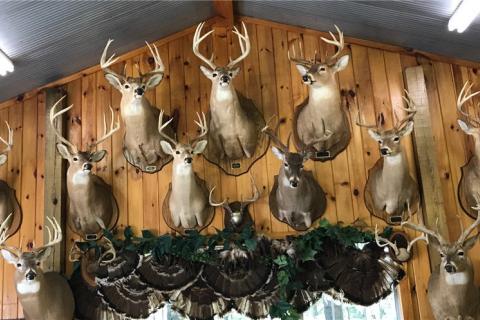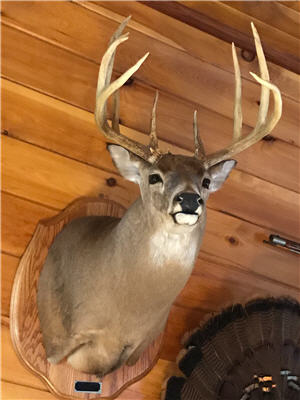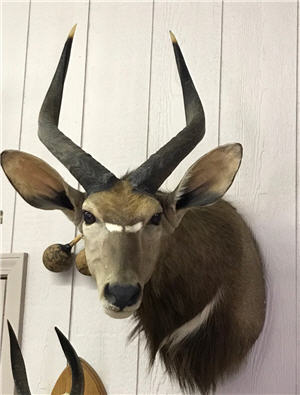
The hard work and anticipation of that special hunt finally paid off with you taking the trophy of your dreams. No matter if the trophy happens to be the record book whitetail you’ve hunted for all your life or if it is your child’s first squirrel, a trophy is in the eye of the hunter.
 After nerves have calmed, stories told and retold and you are anxious to preserve the memories however, the caped head has been resting in the freezer for months simply because you don’t know how to tell the taxidermist what you want. Don’t feel alone, most folks that have ever had taxidermy work done go through this same struggle of decisions.
After nerves have calmed, stories told and retold and you are anxious to preserve the memories however, the caped head has been resting in the freezer for months simply because you don’t know how to tell the taxidermist what you want. Don’t feel alone, most folks that have ever had taxidermy work done go through this same struggle of decisions.
![]() Tip: Taxidermy: How to Care for Deer You Plan to Mount
Tip: Taxidermy: How to Care for Deer You Plan to Mount
We have all seen mounts that are beautiful and lifelike while others may leave a lot to be desired. Over the years I have had 100’s of my animals mounted. I do this to honor the animal as well as to preserve the memory of the hunt and to better share the experience with friends and family. Here are a five key things I’ve learned to insure I’m spending my money wisely on a service and product I’ll be happy with for years to come.
 1. This is VERY important. Decide where the mount will be placed. Find your exact spot on the wall for that big buck, turkey fan etc. Examine the ceiling height making sure there is clearance for antlers. This could make the difference between the type of form you must use such as the: Upright, Sneak, Semi-Sneak, Pedestal or Euro etc.
1. This is VERY important. Decide where the mount will be placed. Find your exact spot on the wall for that big buck, turkey fan etc. Examine the ceiling height making sure there is clearance for antlers. This could make the difference between the type of form you must use such as the: Upright, Sneak, Semi-Sneak, Pedestal or Euro etc.
2. Walk into the room you plan to display the mount and note from which angle will you first see the animal. This will determine which direction you should turn the head as it is desirable to have it facing you when you enter the room. Perhaps you want to admire the trophy from your easy chair in the evenings, I’m sure you will want it facing you from that angle. Focus on the direction of the eyes and the best positioning will become obvious.
 3. To preserve the experience even more I often pose the animal in much the same manner as I saw it in the field through posture, ear position and expression. I shy away from stiff straight forward upright positioning opting more for relaxed graceful turns and flowing lines. Accentuate the most impressive features such as an unusually wide or heavy rack or perhaps a drop-time by placing it in a most obvious focal point. Give the animal back a personality or attitude whenever possible and make sure your taxidermist understands these terms.
3. To preserve the experience even more I often pose the animal in much the same manner as I saw it in the field through posture, ear position and expression. I shy away from stiff straight forward upright positioning opting more for relaxed graceful turns and flowing lines. Accentuate the most impressive features such as an unusually wide or heavy rack or perhaps a drop-time by placing it in a most obvious focal point. Give the animal back a personality or attitude whenever possible and make sure your taxidermist understands these terms.
4. Decide if you want to preserve the imperfections or have them repaired. Sometimes battle scars or ripped ears give character to an old warrior and likely you’d want to keep that look. It requires more work on behalf of the artist but it may be worth it to you. It is commonplace to have broken tines repaired but this is also a personal choice decision. I have had a couple of nice bucks that broke a tine or two when they fell and luckily I was able to find the pieces and have them reattached. If it looks like an old break that happened some time ago I usually opt not to repair but as noted this is everyone’s own choice.
5. Taxidermy is artistry. Look at work done by a variety of taxidermist and don’t choose your artist strictly by price or speed. Make sure you are paying someone that recognizes the beauty of every animal and has the ability and time to bring that beauty to life using quality products and processes that will insure your mount will last a lifetime.
- 8117 views

